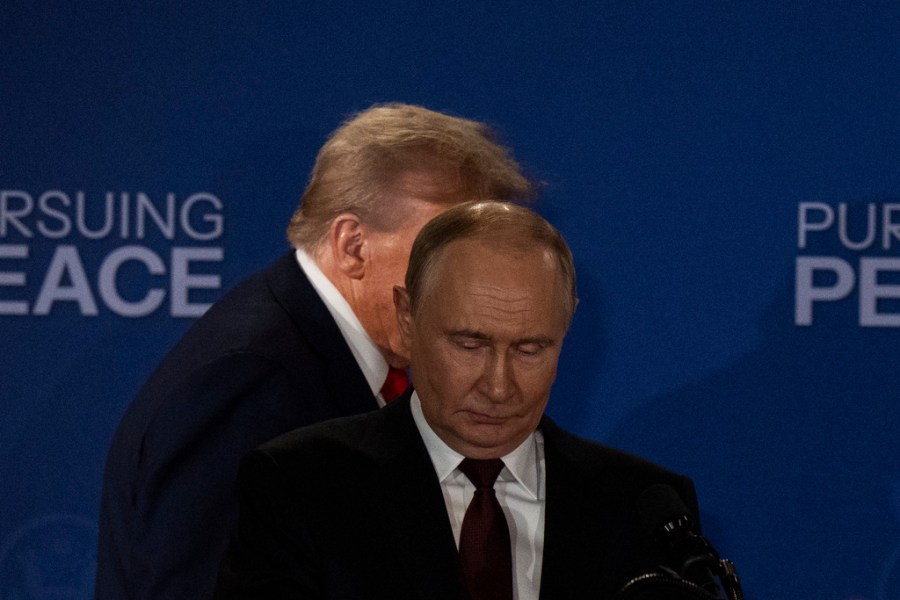Although it was encouraging on Monday to see President Trump meeting with Ukrainian President Volodymyr Zelensky shoulder-to-shoulder, alongside key NATO and European Union leaders in the Oval Office, Russian President Vladimir Putin preemptively delivered an answer to them by launching another intentional attack against Ukrainian civilians.
This time it was in Kharkiv. Seven people were killed including a 15-year-old boy and a one-year-old baby girl.
Putin’s words are fleeting. His actions and that of his regime are what counts. And if we listen to him, he is making it clear that he still intends to get all of Ukraine, one way or the other — either at the negotiating table or on the battlefield.
Team Trump must recognize that Putin is giving them the equivalent of the middle finger. Peace remains elusive in Ukraine. Putin continues to demand total possession of the Russian-occupied territories of Donetsk, Luhansk, Zaporizhzhia and Kherson while retaining Crimea. Zelensky and his European allies were quick to respond with a hard pass.
Team Trump’s threats of harsh sanctions came and went after his Alaska Summit with Putin failed to produce a ceasefire agreement. Putin laughed off the B-2 bomber flyover and proceeded to plant his flag in Anchorage.
The former KGB foreign intelligence officer masterfully used the summit to bank propaganda wins at home, despite the White House’s best spin efforts. Russian Foreign Minister Sergei Lavrov set the tone as he arrived in Alaska by wearing a gray sweatshirt emblazoned with “CCCP” — the Russian acronym for the Union of Soviet Socialist Republics.
Putin’s assault on the post-World War II order continued the following day when he arrived in the U.S. with an International Criminal Court arrest warrant on his head for war crimes in Ukraine. Yet instead of silver handcuffs, he was greeted with a red-carpet rollout on the tarmac, a limousine ride with Trump and was allowed to place flowers at the headstones of fallen Soviet World War II pilots at Fort Richardson National Cemetery.
Putin appeared to convince Trump — again — that it is Zelensky who does not want peace, because he won’t accept Moscow’s conditions for capitulation. Meanwhile, Putin’s army continues to bomb Ukrainian cities with ballistic missiles and drones and his ground forces continue their slow grind of attrition warfare.
Russia keeps attacking — amassing over 1,072,700 casualties in the process. Ukraine keeps defending, and Trump’s frustrations mount. Unlike with the other six peace deals and ceasefires Trump has negotiated, neither Russia nor Ukraine are prepared to concede anything.
Trump is no closer to securing economic deals with Russia; his recourse has been to blame the victim, turning the screws on Zelensky. “President Zelensky of Ukraine can end the war with Russia almost immediately, if he wants to, or he can continue to fight,” Trump recently posted. “Remember how it started. No getting back Obama given Crimea (12 years ago, without a shot being fired!), and NO GOING INTO NATO BY UKRAINE.”
Monday’s round two summit with Zelensky and the European leaders was by all accounts successful. European Commission President Ursula von der Leyen, NATO Secretary General Mark Rutte, U.K. Prime Minister Keir Starmer, German Chancellor Friedrich Merz, French President Emmanuel Macron and Italian Prime Minister Giorgia Meloni joined Zelensky and the President around the Resolute Desk, which presented a united front to Putin and “yielded material outcomes on security guarantees.”
Yet we have seen this movie before. The promise of a one-on-one meeting that never materializes. The man known as Grandpa in his bunker in Russia ultimately walks back any promise of direct interaction with his nemesis, Zelensky. Putin’s Tuesday invitation to Zelensky to meet him in Moscow was disingenuous, and Ukraine promptly rejected it.
Nonetheless, as Secretary of State Marco Rubio stated Sunday on ABC News, “You’re not going to end a war between Russia and Ukraine without dealing with Putin.” That is true, but the problem is, no one will say “No” to Putin. The White House has become a Burger King drive-thru for Putin, where the Russian dictator seems to believe he can “have it his way.”
For Putin, peace requires Ukraine to withdraw from the Donbas — including abandoning its invaluable Fortress Belt that has thwarted Russian ground advances since the war began. If it does so, the White House believes Putin would accept a NATO-like Article Five U.S. security guarantees (perhaps watered-down) for Ukraine.
Yet such a peace would be fleeting. Trump’s Special Envoy Steven Witkoff is naively overvaluing Putin’s offer to enshrine “legislative language [in Russia’s constitution] that they would attest to not attempting to take any more land from Ukraine after a peace deal [and] where they would attest to not violate any European borders.”
Ukraine has already seen this one before. In the 1994 Budapest Memorandum, Russia, the U.K. and the U.S. made security guarantees to Ukraine in exchange for it signing the Treaty on the Non-Proliferation of Nuclear Weapons. The signatories agreed to “respect the independence and sovereignty and the existing borders of Ukraine.” Furthermore, they “reaffirm[ed] their obligation to refrain from the threat or use of force against the territorial integrity or political independence of Ukraine, and that none of their weapons [would] ever be used against Ukraine.”
The Budapest guarantee failed on Feb. 24, 2022, when Putin invaded Ukraine. Needless to say, Ukraine is once bitten, twice shy. By “security guarantee,” they require a legally binding treaty that specifies ironclad commitments. As NATO Secretary-General Mark Rutte told Fox News, “All the details have to be hammered out.”
Trump has ruled out sending U.S. troops to Ukraine. The Kremlin rejects the presence of NATO forces on the ground. NATO will not swim in the deep end without the presence of a U.S. lifeguard.
And although Trump has suggested he will consider providing U.S. pilots and warplanes as part of the security guarantees, authorizing them to directly engage Russian aircraft — unless in self-defense — is unlikely.
As optimistic as many want to be about the potential for a peace deal between Ukraine and Russia, nothing has changed. Even the most junior of intelligence analysts can see that the Kremlin is just angling for time. It needs time to reset, to gain tactical and strategic advantages, and set the conditions for a final push into Ukraine.
No security guarantee that Russia agrees on will stop its next invasion. Putin cannot and will not accept an independent Ukraine.
The war stops when Putin stops attacking. Getting Putin to that point is the solution. His cost calculus remains undetermined, but it is not measured in human lives.
It is time Trump told Putin “Nyet!”
Col. (Ret.) Jonathan Sweet served 30 years as an Army intelligence officer. Mark Toth writes on national security and foreign policy.
Copyright 2025 Nexstar Media, Inc. All rights reserved. This material may not be published, broadcast, rewritten, or redistributed.
For the latest news, weather, sports, and streaming video, head to The Hill.

